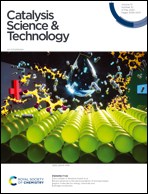Semi-rational hinge engineering: modulating the conformational transformation of glutamate dehydrogenase for enhanced reductive amination activity towards non-natural substrates†
Abstract
The active site is the common hotspot for rational and semi-rational enzyme activity engineering. However, the active site represents only a small portion of the whole enzyme. Identifying more hotspots other than the active site for enzyme activity engineering should aid in the development of biocatalysts with better catalytic performance. Glutamate dehydrogenases (GluDHs) are promising and environmentally benign biocatalysts for the synthesis of valuable chiral L-amino acids by asymmetric reductive amination of α-keto acids. GluDHs contain an inter-domain hinge structure that facilitates dynamic reorientations of the domains relative to each other. Such hinge-bending conformational motions of GluDHs play an important role in regulating the catalytic activity. Thus, the hinge region represents a potential hotspot for catalytic activity engineering for GluDHs. Herein, we report semi-rational activity engineering of GluDHs with the hinge region as the hotspot. Mutants exhibiting significantly improved catalytic activity toward several non-natural substrates were identified and the highest activity increase reached 104-fold. Molecular dynamics simulations revealed that enhanced catalytic activity may arise from improving the open/closed conformational transformation efficiency of the protein with hinge engineering. In the batch production of three valuable L-amino acids, the mutants exhibited significantly improved catalytic efficiency, highlighting their industrial potential. Moreover, the catalytic activity of several active site tailored GluDHs was also increased by hinge engineering, indicating that hinge and active site engineering are compatible. The results show that the hinge region is a promising hotspot for activity engineering of GluDHs and provides a potent alternative for developing high-performance biocatalysts toward chiral L-amino acid production.



 Please wait while we load your content...
Please wait while we load your content...